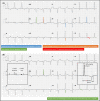Conventional and new electrocardiographic criteria for hypertension-mediated cardiac organ damage: A narrative review
- PMID: 31693279
- PMCID: PMC8030317
- DOI: 10.1111/jch.13726
Conventional and new electrocardiographic criteria for hypertension-mediated cardiac organ damage: A narrative review
Abstract
Hypertension-mediated organ damage (HMOD) is frequently observed in hypertensive patients at different cardiovascular (CV) risk profile. This may have both diagnostic and therapeutic implications for the choice of the most appropriate therapies. Among different markers of HMOD, the most frequent functional and structural adaptations can be observed at cardiac level, including left ventricular hypertrophy (LVH), diastolic dysfunction, aortic root dilatation, and left atrial enlargement. In particular, LVH was shown to be a strong and independent risk factor for major CV events, namely myocardial infarction, stroke, congestive heart failure, CV death. Thus, early identification of LVH is a key element for preventing CV events in hypertension. Although echocardiographic assessment of LVH represents the gold standard technique, this is not cost-effective and cannot be adopted in routine clinical practice of hypertension. On the other hand, electrocardiographic (ECG) assessment of HMOD relative to the heart is a simple, reproducible, widely available and cost-effective method to assess the presence of LVH, and could be preferred in large scale screening tests. Several new indicators have been proposed and tested in observational studies and clinical trials of hypertension, in order to improve the relatively low sensitivity of the conventional ECG criteria for LVH, despite high specificity. This article reviews the differences in the use of the main conventional and the new 12 lead ECG criteria of LVH for early assessment of asymptomatic, subclinical cardiac HMOD in a setting of clinical practice of hypertension.
Keywords: cardiac organ damage; electrocardiogram; hypertension; hypertension-mediated organ damage; left ventricular hypertrophy.
© 2019 Wiley Periodicals, Inc.
Conflict of interest statement
The authors have no conflict of interest to disclose.
Figures
References
-
- Lewington S, Clarke R, Qizilbash N, Peto R, Collins R. Age‐specific relevance of usual blood pressure to vascular mortality: a meta‐analysis of individual data for one million adults in 61 prospective studies. Lancet. 2002;360:1903‐1913. - PubMed
-
- Devereux RB, Bella J, Boman K, et al. Echocardiographic left ventricular geometry in hypertensive patients with electrocardiographic left ventricular hypertrophy: the life study. Blood Press. 2001;10:74‐82. - PubMed
-
- Wachtell K, Olsen MH, Dahlof B, et al. Microalbuminuria in hypertensive patients with electrocardiographic left ventricular hypertrophy: the life study. J Hypertens. 2002;20:405‐412. - PubMed
Publication types
MeSH terms
LinkOut - more resources
Full Text Sources
Medical


